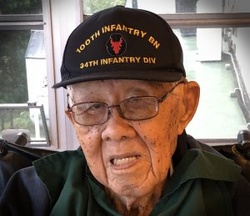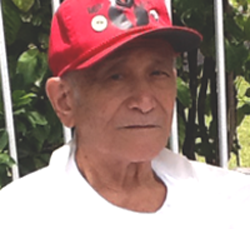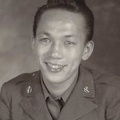The 80th Anniversary Committee of the 100th Infantry Battalion Veterans organization compiled a list of known survivors here and on the mainland who served in the World War II 100th Infantry Battalion. With this publication there are 12 known surviving Nisei warriors—nine in Hawai‘i and three on the mainland.
Working with the committee here and the Go For Broke National Education Center in Los Angeles, The Hawai‘i Herald tried to reach the 12. Four of the 100th Infantry Battalion veterans’ families lost everything when they were among the 120,000 West Coast Japanese Americans who were forced to leave their homes and imprisoned behind barbed wire fences. A few 100th Infantry Battalion veterans chose not to participate in this interview. Some were never located. These are their stories and their photos (provided by their families).
* * * * *
The formation of the Army’s segregated 100th Infantry Battalion 80 years ago is a story of boys who went to war and after they returned changed the fabric of Hawai‘i. Many are gone and their stories are losing a battle with time, the battle to preserve their legacy. Their story is powerful – filled with the fight against racial prejudice and war hysteria, the loss of civil liberties and the failure of political leadership.
Historian Thomas Murphy, in his 1954 book Ambassadors in Arms, said at least 95% of the original members of the “Hawaii Battalion” were sons of immigrants. “Some 35% were dual citizens and about 2% were ‘Kibei,’”—born in America, but educated in Japan. The unit earned the distinction of the “Purple Heart Battalion” with 1,703 Purple Heart medals, eight Medals of Honor, 17 Distinguished Service Crosses and 147 Silver Stars. Four were captured by the Germans and two died in German POW camps. It was the first Japanese American unit to face combat in Europe in World War II.
Of the 3,147 Nisei (second-generation Japanese American) warriors who served in the 100th Infantry Battalion, (nicknamed “One Puka Puka”) and who fought in North Africa, Italy, and France from September 1943 to May 1945, only a very few remain—all of them pushing the century mark. The records of the 100th Infantry Battalion show that of 3,147 soldiers, 15% were from the mainland.
Janice Sakoda, a member of the planning committee, said:
“The 80th Anniversary Committee believes it’s important for our community to know about the men of the 100th because these men—many from humble beginnings—performed exceedingly well and sacrificed much, both during and after the war. They were able to accomplish much despite adversity, prejudice, and many other challenges to change their lives politically, socially and economically. We’re hoping that the community, in particular the youth, will learn that despite their personal adversities, prejudice, and other challenges they are faced with, they too can overcome through perseverance, by doing their best, and even through sacrifice.”
“We are all Hawaiian at heart,” historian and journalist Tom Coffman quotes 100th Infantry Battalion soldier Sgt. (later lieutenant) Conrad Tsukayama in his 2022 book Inclusion. “The basic ‘ohana (family) spirit came from Native Hawaiian people, an ethnic group filled with genuine aloha, the magic ingredient that brought together the hearts of all the oppressed immigrants’ sons.
“We carried this spirit of aloha wherever we went,” said Tsukayama who was a member of the 100th Infantry Battalion’s D Company and in September 1943 became the 100th Infantry Battalion’s first casualty when he was injured by a mine. He left the hospital without being discharged just so he could be with his comrades.
The Nisei soldiers had been members of the multi-cultural Territorial pre-war Hawaii National Guard’s 298th Infantry Regiment with soldiers from O‘ahu and the Neighbor Islands’ 299th Infantry Regiment, as well as activated reservists. But only the Nisei soldiers were transferred to the newly created Hawaii Provisional Infantry Battalion because the government didn’t know what to do with the Japanese Americans at the start of the war in the Pacific.
Before the soldiers disembarked in Oakland on June 12, 1942, for training in Wisconsin, it was redesignated as the 100th Infantry Battalion (Separate). The 100th was not the only unit in the Army whose members were of the same ethnic stock—the 99th Infantry Battalion was predominantly Norwegian; the 101st Battalion was Austrian, and the 122nd Battalion was Greek, according to 100th Infantry Battalion veteran Jack Nakamura.

Edward Ikuma is believed to be the last surviving member of 1,432 Japanese American men of the Hawaii Provisional Infantry Battalion that snuck out of Honolulu at midnight on the eve of the battle for Midway Atoll in June 1942 aboard the S.S. Maui, a 25-year-old Matson steamer capable of carrying 1,650 passengers. There were few tearful farewells by family members since the soldiers left in secret because of the government’s fear of further attacks by the Japanese after its Dec. 7, 1941, raid on Pearl Harbor.
Tsukayama recalled in the 1998 volume of Japanese Eyes American Heart there was “one elderly Japanese mother waving good-bye to us” when the train he was on left Schofield Barracks and “handful of Nisei girls waved from the pier as the SS Maui pulled away from the dock.”
Ikuma is 103 years old and has hearing problems. However, he recalls, with the help of his son, retired Cold War jet fighter pilot Navy Capt. Gary Ikuma, that when the provisional battalion shipped out, none of the men could say goodbye to friends and family. “No phone calls were allowed. It was such a secret that nobody even knew where they were going … (but) the soldiers were in good spirits and considered it an adventure.
Having formed many close bonds in training camps and on the French and Italian battlefields, the Nisei warriors counted on each other for survival.
The war and the 100th Infantry Battalion, Capt. Ikuma believes, was “the most defining experience of [his] life.” He said his dad believes this because he served with the same soldiers through the entirety of World War II.
“They served in combat for a very long time and, all the while, it was a matter of life and death. With so many casualties, soldiers never knew when their luck would run out. He formed many close bonds while in the 100th and the soldiers depended on each other for survival in combat.”
Capt. Ikuma continued to speak for his father and said:
“As a soldier in the 100th, he felt a deep sense of obligation to his family, fellow soldiers and country; to serve with honor, and not bring shame, despite the dangers and hardships. He and his 100th comrades were determined to prove their loyalty to the country through perseverance and great sacrifice in combat.”

“He was a ‘kotonk’ (mainland born Japanese American) thrown in with pidgin talkers, and he came to love them … He loved the men who he believed saved his life, by teaching him to survive in combat.”
The training record of the 100th Infantry Battalion paved the way for the creation of the 442nd Regimental Combat Team—an Army unit comprised mainly of Nisei men from Hawai‘i and the mainland. In January 1942 the U.S. War Department’s organizational plan for the segregated unit specified that “all officers down to the company commander level were to be ‘white American citizens,’” according to Unlikely Liberators, published by the University of Hawai‘i Press in 1985 by Masayo Umezawa Duus. “The only exception was Capt. Pershing Nakada, commander of the 232nd Engineer Company.” Most of the platoon leaders were also Caucasian.
In 1943 the 442nd Regimental Combat Team was created along with the reinstatement of the draft of Japanese American men a year later. In June 1944, the 100th Infantry Battalion was attached to the 442nd Regimental Combat Team as the regiment’s 1st Battalion and was allowed to keep its designation, 100th, because of its outstanding record in combat. Together the unit achieved the accomplishment of being the most decorated Army unit for its size and duration of service.
Although there are many rosters and lists of the officers and enlisted men who served in the 100th Infantry Battalion and the 442nd Regimental Combat Team, there is no accounting of all of them after the regiment was demobilized and deactivated in August 1946. Many simply chose not to have anything to do with the war and simply faded into history.
For others, like Ikuma, they remained bonded and organized Club 100 and the 442nd Veterans Club with the two organizations becoming a meaningful part of their post-war lives. The Nisei veterans, and now their children, here and on the mainland, continue to keep their struggles and achievements alive.
Capt. Ikuma said “the 100th was still a big part of [his] father’s life, with club activities, and seeing and socializing with fellow 100th veterans. They had been through so much together during the war, and they stayed together afterwards.”
Sakoda said each chapter (of Club 100) used to keep in touch with the veterans (war buddies) but over the years, the “telephone tree” faded away. “Each chapter of Club 100 represented a company in the battalion during the war. There is only one chapter for neighbor island veterans because there were not enough of them from the same company to form individual chapters on each island.”
The veteran’s Club 100 was “intended to serve not only as a social and mutual assistance organization for its members and families, but as an association dedicated to promoting the unity and welfare of all the people of Hawai‘i,” Murphy wrote in his book on the 100th Infantry Battalion. To commemorate the battalion’s 10th anniversary and the construction of a new clubhouse near the Ala Wai canal, its members adopted the slogan “For Continuing Service,” Murphy wrote. The clubhouse property had been purchased using funds from a payroll deduction plan the soldiers had started while training at Camp McCoy in Wisconsin.
*This article was originally published in The Hawai'i Herald on June 3, 2022
© 2022 Gregg K. Kakesako / The Hawai'i Herald










